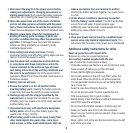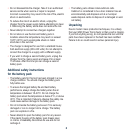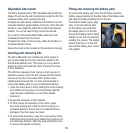8
• Do not disassemble the charger. Take it to an authorised
service centre when service or repair is required.
Incorrect re-assembly may result in the risk of fire, electric
shock or electrocution.
• To reduce the risk of an electric shock, unplug the
charger from the power supply before attempting to clean
it. Removing the battery alone does not reduce the risk.
• Never attempt to connect two chargers together.
• Do not store or use the tool and battery pack in
locations where the temperature may reach or exceed
104°F (40°C) such as alongside sheds or metal
structures in the summer.
• The charger is designed for use from a standard house-
hold electrical supply (230–240 volts). Do not attempt to
connect the charger to a supply with a different supply.
• If you wish to charge a second battery pack, unplug the
charger from the mains supply and leave it for at least
15 minutes. After this time you can charge a second
battery pack.
Additional safety instructions
for the battery pack
• The battery pack for this tool has been shipped in a low
charge condition. You should charge the battery pack
fully before use.
• To ensure the longest battery life and best battery
performance, always charge the battery when the air
temperature is between 18–24°C. Do not charge the
battery pack when the temperature is below 0°C, or above
40°C. This is important. Failure to observe this safety rule
could cause serious damage to the battery pack.
• Do not incinerate the battery pack even if it is seriously
damaged or can no longer hold a charge. The battery
pack can explode in a fire.
• Never attempt to open the battery pack for any reason.
If the plastic housing of the battery pack breaks open
or cracks, immediately discontinue its use and do not
recharge it.
• The battery pack utilizes nickel-cadmium cells.
Cadmium is considered to be a toxic material. Use an
environmentally safe disposal unit at a municipal
waste disposal centre to dispose of a damaged or worn
out battery.
Unpacking
Due to modern mass production techniques, it is unlikely
that your GMC Power Tool is faulty or that a part is missing.
If you find anything wrong, do not operate the tool until the
parts have been replaced or the fault has been rectified.
Failure to do so could result in serious personal injury.


















